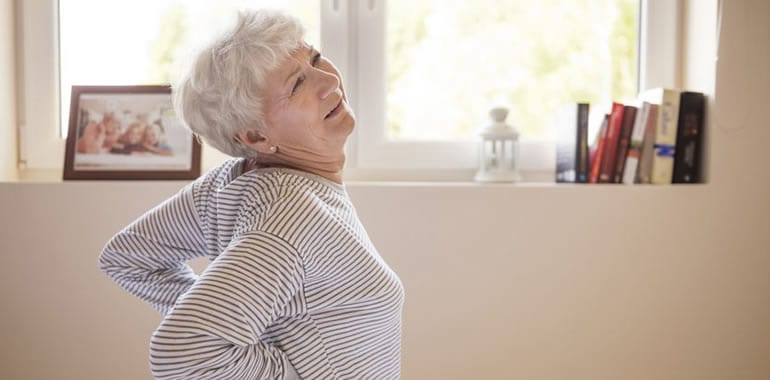
What is Acute Low Back Pain?
Acute low back pain is one of the most common reasons people go see the doctor and/or miss days at work. 80-85% of people will experience low back pain within their lifetime. In addition, low back pain is the leading cause of years lived with disability, according to the Global Burden of Disease Study of 2017. Americans will spend at least $50 billion each year on treatment of low back pain.
Acute low back pain is defined as an episode of back pain that lasts less than 4 weeks. People can develop acute back pain suddenly like when someone goes to lift up a heavy object and feel a sudden, sharp pain in their back. Acute back pain can also develop gradually over time. Fortunately, in most cases, acute back pain is not due to a serious pathology.
About 90% of people see their symptoms resolve on their own without intervention. According to Pengel et al., people saw their low back pain improve significantly within one month. In addition, they saw that folks were able to return to work within one month. However, sometimes it can linger, which motivates patients to seek help from a healthcare professional.
Red Flags
Most acute low back pain episodes don’t indicate a serious pathology. However, there are red flag symptoms that should be noted and you should seek immediate help from a healthcare professional if you exhibit any of these symptoms:
Do You Need Imaging?
After a severe episode of acute low back pain, many folks tend to want to imaging done, such as a MRI, X-Ray, or CT scan to see what is wrong with their back and potentially find out what is causing their pain. However, for many cases, imaging is not required. It has shown been shown in research that imaging will likely not alter the treatment plan or improve outcomes. The American Academy of Family Physicians recommend that MRIs should be withheld for the first 6 weeks if there are no red flag symptoms present. Early, unnecessary MRI imaging may even produce worse outcomes. According to Webster et al., people that undergo early MRI imaging “are more likely to have prolonged disability, higher medical costs, and greater utilization of surgery.”
In addition, pathological imaging does not usually correlate to pain. If you performed imaging on everybody’s back, you will likely see something abnormal, including disc herniation’s, age-related degenerative changes, etc, but many folks are walking around without pain despite these findings.
Unless you are experiencing signs of a more serious pathology, you do not require imaging for your back. It will prevent unneeded exposure to radiation and it will save you a lot of money and time as well.
Self-Treatment Tips
It is important to keep yourself moving after suffering an episode of acute back pain. Prolonged bed rest is NOT recommended to treat acute back pain. Bed rest can actually slow down recovery. Prolonged bed rest can cause detrimental effects to the body such as decreased muscle strength and bone density as well as negative effects to the cardiovascular and respiratory system. According to Guedes et al., a patient can experience up to 5% of muscle strength loss per day of bed rest.
So, being active is the KEY to a quick recovery. Dahm et al. found that people, who were advised to stay active, experienced small improvements in function and pain compared to those advised to rest in bed.
As you recover, initially try activities that are not too intense. You want to ease yourself back into your regular activities as you recover. Walking is an easy and low-intensity activity to do when dealing with acute back pain. You can also consider yoga or swimming if you enjoy those activities. Remember discomfort is expected during this time, so do not worry that you are making your back pain worse by walking or exercising. Pain does not always equal tissue damage.
You can consider performing exercises utilized in the McKenzie method to help relieve the back pain. One exercise you can try at home is called standing lumbar extensions.
After performing 10 repetitions of this exercise, observe your symptoms. If the pain moves towards the center of your back, then this movement is the correct one for you. This phenomenon is known as “centralization.” It means the pain is moving towards the source of the pain at the spine, which is a great sign. We usually recommend that you perform this exercise every 2 hours during the day. You should see improvement within 2-3 days as you continue to do these exercises.
However, if the pain starts to move across your back and/or down your legs, stop performing this exercise immediately. This is known as “peripheralization”, meaning you are putting more stress on the nerve and this is not the correct movement for your back pain.
It is important to note that pain level is not as important if the symptoms are centralizing or peripheralizing. So if you are experiencing an increase in pain, but the symptoms are centralizing, it is still a good sign. This also works the other way as well. If the pain is decreasing, but the symptoms are expanding across your back and down your legs, it is still a bad sign.
We usually recommend people dealing with acute low back pain to not sit for a prolonged period of time. Try to stand up and move around every 20-30 minutes to prevent stiffness and to take pressure off the back and to prevent stiffness. One trick is to set a timer for yourself on your phone as a reminder to get up and move around.
If you are having difficulty sleeping while dealing with acute low back pain, you can easily modify your sleeping position to get you more comfortable. If you prefer to sleep on your back, you can place a pillow under your knees to place your spine in neutral to decrease the stress on your back. If you like to sleep on your side, you can put a pillow between your knees to get your hips, pelvis, and spine in good alignment. For folks who like to sleep on their back, you can place a pillow under your hips and abdomen to relieve some pressure on your back.
For temporary pain relief, you can also use a heat pack and place it on the affected area. To prevent burning, make sure you cover the heat pack with at least four towels. You can leave the heat pack on for 10-20 minutes. Caution using a heat pack if you have impaired sensation as you may not be able to recognize that the heat pack is too hot and it can lead to a burn.
In addition, with consultation with your doctor, you can also opt to take over the counter pain medications, such as acetaminophen (Tylenol) or NSAIDS (Advil). If you are having difficulty dealing with the pain and/or it is disturbing your sleep, these medications can give short-term relief. It’s important to consult with your doctor before deciding to take these over the counter medications as they can have side effects and/or can interact with the current medications you are taking.
Prevention of Further Episodes
To prevent further episodes of acute low back pain, it is very important to keep yourself healthy and strong by exercising regularly. While it is impossible to 100% prevent new episodes of acute back pain, you can lower your risk through exercise and becoming strong. Also, the stronger you are, the better you can cope with another spell of acute low back pain.
According to research, exercise frequency is more important than the specific type, duration, or intensity of exercise. So, the best type of exercise to prevent acute low back pain is the one you love and are willing to perform consistently during your daily routine.
If you continue to struggle with low back pain that won’t go away, we, at Apex Orthopedic Rehabilitation, can help get you back to moving well again and be able to do the activities you want to do in your life.
Dr. Gil Santos Staff Physical Therapist at Apex Orthopedic Rehabilitation


